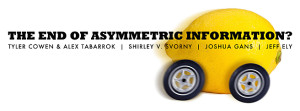The End of Asymmetric Information?
 At Cato Unbound, Tyler and I ask whether the age of asymmetric information is ending and what implications this may have for regulation and markets. The Browser offers an excellent precis:
At Cato Unbound, Tyler and I ask whether the age of asymmetric information is ending and what implications this may have for regulation and markets. The Browser offers an excellent precis:
Sensors and reputation systems allow buyers to know what sellers know, principals to know what agents know, and vice-versa. Akerlof’s arguments have been overtaken. Any interested party can have access to information about product quality, worker performance, the nature of financial transactions. “A large amount of economic regulation seems directed at a set of problems which, in large part, no longer exist”
The end of asymmetric information will make markets work better but also governments. Here is one bit:
Many “public choice” problems are really problems of asymmetric information. In William Niskanen’s (1974) model of bureaucracy, government workers usually benefit from larger bureaus, and they are able to expand their bureaus to inefficient size because they are the primary providers of information to politicians. Some bureaus, such as the NSA and the CIA, may still be able to use secrecy to benefit from information asymmetry. For instance they can claim to politicians that they need more resources to deter or prevent threats, and it is hard for the politicians to have well-informed responses on the other side of the argument. Timely, rich information about most other bureaucracies, however, is easily available to politicians and increasingly to the public as well. As information becomes more symmetric, Niskanen’s (1974) model becomes less applicable, and this may help check the growth of unneeded bureaucracy.
We discuss used cars and Akerloff’s model for lemons, moral hazard problems, principal-agent problems, reputation mechanisms, computable contracts and much more.
We will be joined in future discussion by Joshua Gans, Shirley V. Svorny, and Jeff Ely.